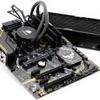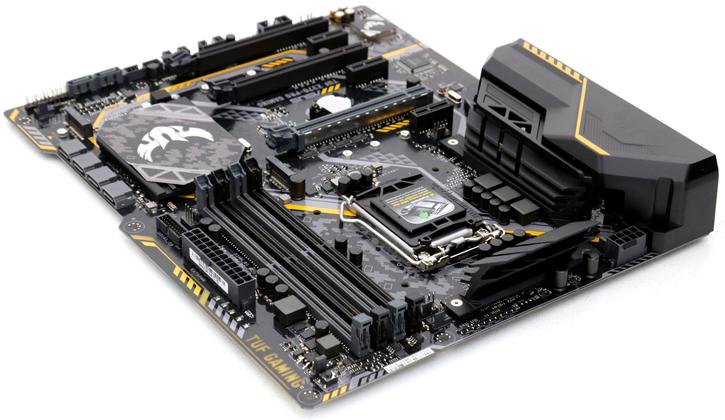Final Words & Conclusion
Conclusion
Okay, can I just say MSI X99 XPower theme here for just a second :) Come on, right? Haha, ah well. the new TUF is definitely looking a bit different from what we have seen the past few years in the camo styled boards. Admittedly, initially I did not like the new style and colors, but the truth is, it's growing on me. Hey, taste and thus styling is a personal preference so yes, this board will not agree with some, but will with others. The good news is that the board sits in a sub 200 USD price category. In fact, I have been able to spot it a moment ago for 175 Euros. I do hope it drops a little more as the board itself really is quite standard, features wise. But it's a nice board though as all main features are there as well as the performance and, sure enough, it tweaks as well as the others also. Really all Z370 boards perform roughly within the same 2% margin of error with an exception here and there. That goes for overclocking and tweaking as well, of course, the denominator here is the processor and not so much the motherboard. Overclocking wise we can reach 5.2 GHz on all six cores 100% stable on our sample, but we've also seen others hardly reach 4.8 GHz. You'll likely see some samples hit 5.3 and others 5.0, but it is around this range. The platform (Z370/Coffee Lake) also manages heat and power consumption at very acceptable levels.
Performance & tweaking
Once tweaked we noticed that the six cores like a bit of extra voltage, we expect all-core tweaks in the 5.1~5.2 GHz marker to need ~1.40 Volts on the processor. While that does increase power consumption, it wasn't something that scared me away. Some platforms and procs will also be able to manage a lower voltage. We tried this board with the CPU at 1.425 volts / 5.2 GHz frequency ranges and it reached a scary 90 Degrees C for that 5.2 GHz (all cores though), and that is tricky. We did use an ES sample, perhaps the final retail product can do with a little less juice. If you plan a tweak at that 5 GHz marker then remember my remarks on cooling, you will need LCS, that or a very good heat pipe cooler. Again, we have been using an ES sample so I cannot say anything conclusive on the final retail products (these might run a tiny bit cooler). The infrastructure that Z370 offers is easy to use, you increase the CPU voltage and multiplier and you are good to go. Another plus for the Intel platform is that over the years they have been able to refine their memory controllers, pop in anything XMP 2.0 and you have a 90% chance it'll work straight out of the box with very fast memories. Keep in mind that all our tests are performed at 3200 MHz DDR4, similar to Ryzen and Threadripper to remain objective and for fair play on both sides.
Power consumption
Z370 with a six core, twelve thread proc equates to a 95 Watt TDP processor. With the system at idle with a GeForce GTX 1080 installed / 16 GB memory / SSD and the Z370 motherboard, typically you will hover at roughly 50 Watts in IDLE. The board is at the baseline of the rest of the tested Z370 motherboards. When we stressed the processor 100% we reach roughly 150 Watts with the 6-core 8700K part overall. When we game we hover at ~250 Watts with the GeForce GTX 1080, but obviously that factor is dependent on the type of graphics card you use of course and sure, most games certainly do not utilize the six CPU cores. Overall I have no worries here.
DDR4 Memory
For Coffee Lake (8th Gen Intel procs) DDR4 may be clocked a notch faster at 2400/2667 MHz as per Intel reference. We always say, volume matters more than frequency. A 3200 MHz kit, for example, is far more expensive and does offer better bandwidth but the performance increases in real-world usage will be hard to find. Unless you transcode videos over the processor a lot. As always, my advice would be to go with lower clocked DDR4 memory with decent timings, but get more of it. Don't go for 8 GB, get four DIMMs and, in total, a minimum of 16 GB. The reason we test at 3200 MHz is simple, we do the same for AMD Ryzen and want to create a fair and equal playing ground for both.
Final words
The new TUF is a fairly standard board but is priced like that as well, which is a good thing. the ASUS design team overhauled the board, gave it a bit of different color schema, and hey, did you notice the funky PCB cut-out at the SATA ports location? It's different, and I do like that albeit I also understand that the design and colors are not everyone's cup of tea. The perf offered in a default configuration is totally within the baseline, it tweaks well. There isn't much RGB going on, and yeah, that's appreciated by some I guess. Lacking again is WIFI, neither does it come with a preferred 5G or 10G LAN Jack. Connectivity wise, in terms of your PCIe slots for your graphics subsystem you are looking at a full x16 Gen3 lanes for one graphics cards. The second PCIe slot shares its lanes with the first one, ergo you'd end up at a configuration like x8/x8. The third x16 slot is, in fact, a x4 slot which draws its lanes from the chipset. We expect most K model Coffee Lake procs to be able to roughly hit that 5 GHz domain on all cores with exceptions running up towards 5.2 GHz (all-cores). I base this metric on high-perf air coolers and liquid cooling. From there onwards you are looking at proc ASIC quality and cooling being the more important denominator. Concluding, the new TUF is a bit out of the ordinary. But it grows on me design wise as it is a little different. Perf and features wise it's all roughly the same though, including the tweaking experience as the limiting factor will be the proc and not so much the motherboard and its firmware. We like what we fooled around with. If you dig the new styling and seek something a bit more affordable, sure, why not? The z370 tuf pro is currently 129.99 USD on newegg! Recommended by Guru3D.com.
Handy related downloads:
- Sign up to receive a notice when we publish a new article
- Or go back to Guru3D's front page.



